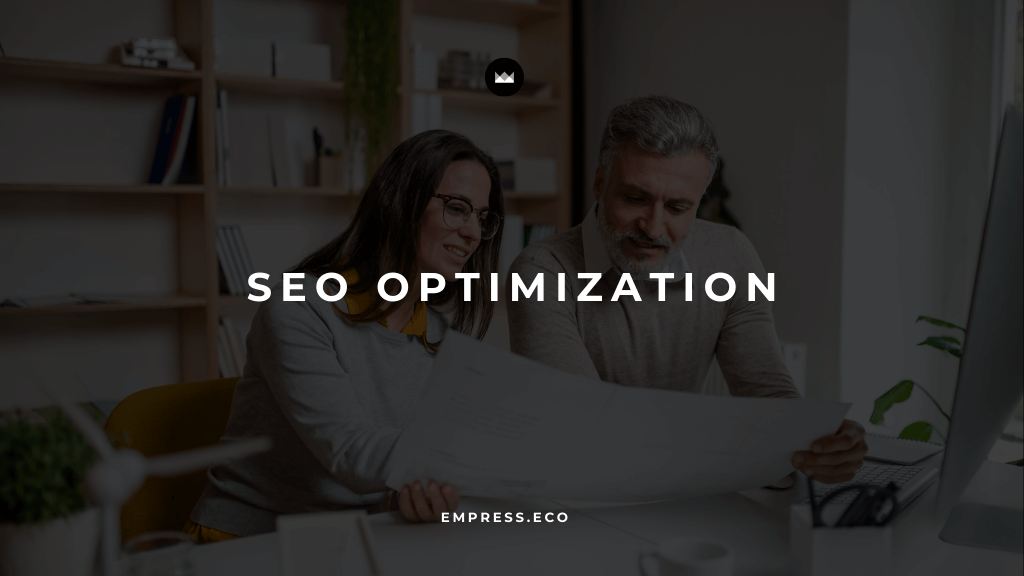
SEO Optimization: Boosting Search Rankings and Attracting Organic Traffic
Table of Contents
In the digital age, where online visibility can make or break a business, Search Engine Optimization (SEO) stands as one of the most crucial components of a successful digital marketing strategy. SEO is not just about attracting more visitors to your website; it’s about drawing the right kind of traffic—those who are actively searching for what you offer. By strategically optimizing your website for search engines, you can elevate your search rankings, attract high-quality organic traffic, and achieve sustainable growth.
In this comprehensive guide, we’ll delve into the key strategies for effective SEO optimization, explore the benefits of a well-executed SEO plan, and discuss the challenges businesses might face in the ever-evolving SEO landscape.
The Power of SEO Optimization
SEO optimization is the art and science of making your website more attractive to search engines like Google. When done right, it can transform your website from a hidden gem to a well-trafficked digital destination. But why exactly is SEO so powerful?
1. Improved Search Rankings
The most immediate and obvious benefit of SEO is improved search rankings. When your website appears at the top of search engine results pages (SERPs), it’s more likely to attract clicks from potential customers. Consider this: the first page of Google captures 71% of search traffic clicks, with the top three results receiving the lion’s share of those clicks. If your business isn’t ranking on the first page, you’re missing out on a significant amount of potential traffic and customers.
Effective SEO strategies ensure that your website is optimized for the right keywords—those that your target audience is searching for. By focusing on these keywords, you can push your website higher in the rankings, making it more visible to users who are actively seeking your products or services.
2. Increased Organic Traffic
Organic traffic, which refers to visitors who find your site through unpaid search results, is one of the most valuable sources of website traffic. Unlike paid ads, which require a continuous investment to maintain visibility, organic traffic is sustainable. Once you’ve achieved a good ranking through SEO, you can continue to attract visitors without ongoing costs.
By optimizing for relevant keywords and search terms, you can ensure that your website attracts traffic from users who are more likely to convert. This not only increases your overall traffic but also improves the quality of that traffic—bringing in visitors who are genuinely interested in what you offer.
3. Enhanced User Experience
SEO isn’t just about search engines; it’s also about users. A significant part of SEO involves optimizing the structure, speed, and content of your website to ensure a positive user experience. Search engines like Google prioritize websites that offer a seamless experience, meaning that the better your site is for users, the better it will rank.
Improving your website’s load time, making navigation intuitive, and ensuring that content is relevant and engaging are all critical aspects of SEO. These elements not only help with rankings but also keep visitors on your site longer, reduce bounce rates, and increase the likelihood of conversions.
4. Long-Term Results
One of the most compelling reasons to invest in SEO is its potential to deliver long-term results. While paid advertising stops bringing in traffic as soon as you stop paying, the benefits of SEO can last for years. Once your website is well-optimized and ranks highly for relevant keywords, it will continue to attract organic traffic over the long term.
This doesn’t mean that SEO is a set-it-and-forget-it strategy—far from it. The SEO landscape is constantly changing, and it requires ongoing effort to maintain and improve your rankings. However, the initial investment in SEO can yield long-lasting benefits, making it a more cost-effective strategy in the long run compared to paid advertising.
Implementing Effective SEO Strategies
To harness the power of SEO and boost your search rankings, you need to implement a well-rounded strategy that covers all aspects of optimization—from keyword research to content creation, and from technical SEO to link building. Here’s how to do it effectively:
1. Conduct Keyword Research
Keyword research is the foundation of any successful SEO strategy. It involves identifying the words and phrases that your target audience is using to search for products or services similar to yours. By optimizing your website for these keywords, you can ensure that your site appears in search results when users are looking for what you offer.
Start by brainstorming a list of potential keywords related to your business. Then, use keyword research tools like Google Keyword Planner, Ahrefs, or SEMrush to expand your list and identify keywords with high search volume and low competition. Focus on both short-tail keywords (e.g., “SEO services”) and long-tail keywords (e.g., “affordable SEO services for small businesses”), as the latter often have lower competition and can attract more targeted traffic.
Once you’ve identified your target keywords, incorporate them naturally into your website’s content, meta tags, headings, and URLs. But remember—keyword stuffing (the practice of overloading your content with keywords) can actually harm your rankings, so use keywords judiciously and focus on creating high-quality content that provides value to your visitors.
2. Optimize On-Page Elements
On-page SEO refers to the practice of optimizing individual pages on your website to rank higher and earn more relevant traffic. This involves several key elements, including:
- Title Tags: The title tag is one of the most important on-page SEO elements. It tells search engines what your page is about and appears as the clickable headline in search results. Make sure your title tags are descriptive, include your target keywords, and are within the 50-60 character limit.
- Meta Descriptions: The meta description is a brief summary of the page that appears below the title tag in search results. While it doesn’t directly impact rankings, a well-written meta description can improve click-through rates by enticing users to click on your link. Include your target keywords and keep it under 160 characters.
- Headings (H1, H2, H3, etc.): Headings help organize your content and make it easier for users and search engines to understand. Use H1 tags for the main title of the page, and H2 or H3 tags for subheadings. Include keywords where appropriate, but prioritize readability and structure.
- Image Alt Text: Search engines can’t “see” images, so they rely on alt text to understand what an image is about. Use descriptive alt text that includes relevant keywords to improve your image search rankings and overall SEO.
- URLs: Use clean, descriptive URLs that include your target keywords. Avoid using long strings of numbers or irrelevant words, as these can confuse both users and search engines.
3. Improve Website Structure and Speed
A well-structured, fast-loading website is essential for both user experience and SEO. Search engines prefer websites that are easy to navigate and load quickly, as these factors contribute to a positive user experience.
- Website Structure: Ensure that your website has a clear, logical structure that makes it easy for users to find the information they’re looking for. Use a hierarchy of pages with a clear navigation menu, and include internal links to guide users to related content.
- Mobile Optimization: With more than half of all web traffic coming from mobile devices, having a mobile-friendly website is no longer optional—it’s a necessity. Use responsive design to ensure that your site looks and functions well on all devices, and test it regularly to identify and fix any issues.
- Page Speed: A slow-loading website can frustrate users and lead to higher bounce rates, which can negatively impact your rankings. Use tools like Google PageSpeed Insights to assess your site’s loading speed and identify areas for improvement. Common solutions include compressing images, leveraging browser caching, and minimizing code.
4. Create High-Quality Content
Content is king in the world of SEO. High-quality, relevant content not only attracts visitors but also encourages them to stay on your site longer, explore more pages, and ultimately convert. Additionally, great content is more likely to be shared and linked to by other websites, which can boost your SEO.
When creating content, focus on addressing the needs and interests of your target audience. This could include blog posts, articles, how-to guides, videos, infographics, and more. Make sure your content is informative, engaging, and optimized for your target keywords.
Regularly updating your content is also important. Search engines favor fresh content, so keep your site active by publishing new articles, refreshing old content, and removing outdated information.
5. Build Backlinks
Backlinks, or inbound links from other websites to yours, are a critical factor in SEO. They act as votes of confidence from other sites, signaling to search engines that your content is valuable and trustworthy. The more high-quality backlinks you have, the better your site is likely to rank.
There are several strategies for building backlinks:
- Guest Blogging: Write articles for other reputable websites in your industry and include links back to your site. This not only builds backlinks but also positions you as an authority in your field.
- Content Outreach: Reach out to other websites and bloggers who might be interested in linking to your content. This works particularly well if you’ve created high-quality, unique content that provides value to their audience.
- Social Media Promotion: Share your content on social media to increase its visibility. While social media links don’t directly impact SEO, they can drive traffic to your site and lead to more backlinks over time.
Challenges and Considerations in SEO Optimization
While SEO optimization offers numerous benefits, it’s not without its challenges. Understanding these challenges and knowing how to navigate them is key to maintaining and improving your search rankings.
1. Algorithm Changes
Search engines like Google frequently update their algorithms to improve search results. While these changes are designed to enhance user experience, they can also impact your rankings—sometimes dramatically. Staying updated on algorithm changes and adjusting your SEO strategies accordingly is essential for maintaining your rankings.
2. Competitive Landscape
In competitive industries, achieving and maintaining high rankings can be challenging. Competitors may be targeting the same keywords, making it difficult to stand out. To succeed, you’ll need to continuously refine your SEO strategies, stay ahead of industry trends, and possibly explore niche keywords or long-tail variations that are less competitive.
3. Resource Commitment
Effective SEO requires a significant investment of time, effort, and resources. From content creation to technical optimization, the various aspects of SEO demand ongoing attention. Businesses must be willing to allocate the necessary resources—whether that means hiring in-house experts, outsourcing to an SEO agency, or investing in advanced tools.
Conclusion
SEO optimization is a powerful tool for boosting search rankings, attracting organic traffic, and driving long-term growth. By implementing a comprehensive SEO strategy that includes keyword research, on-page optimization, content creation, and link building, businesses can enhance their online presence and achieve their marketing objectives.
As the digital landscape continues to evolve, staying ahead of SEO trends and adapting to changes in search engine algorithms will be essential for maintaining a competitive edge. With a commitment to continuous improvement and a focus on delivering value to users, your business can harness the full potential of SEO to achieve lasting success.
Empress Newsletter
Join the newsletter to receive the latest updates in your inbox.



